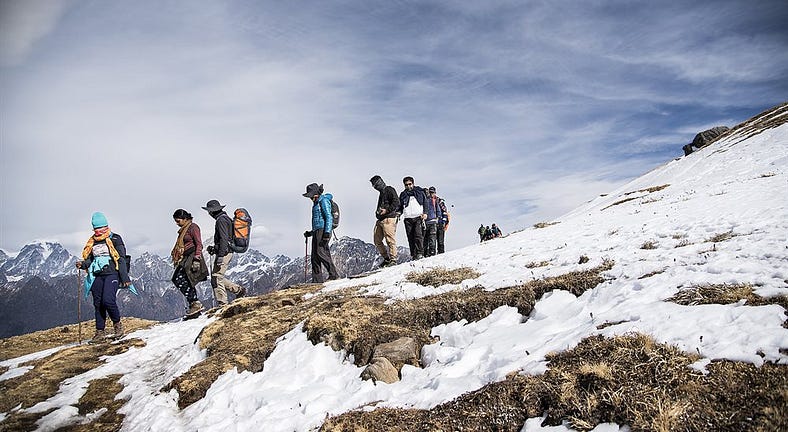The Kuari Pass Trek, also known as the Lord Curzon Trail, is one of the most scenic and accessible treks in the Indian Himalayas. Nestled in the Garhwal region of Uttarakhand, this trek offers breathtaking views of some of the highest peaks in India, including Nanda Devi, Dronagiri, Kamet, and Hathi Ghoda Parvat. The trek is named after Lord Curzon, the then Viceroy of India, who is said to have explored this route in the early 20th century.
In this guide, we’ll delve into everything you need to know about the Kuari Pass Trek, from its history to what you can expect on the trail, and why it should be on every trekker’s bucket list.
1. A Glimpse into the History of Kuari Pass Trek
The Kuari Pass Trek holds a special place in the history of Indian trekking. In 1905, Lord Curzon embarked on this trail, and since then, it has been affectionately referred to as the Lord Curzon Trail. The trek was originally developed as a route to explore the rich biodiversity and the majestic views of the Garhwal Himalayas. Over the years, it has gained popularity among trekkers, both beginners and seasoned adventurers, for its relatively moderate difficulty level and stunning scenery.

2. Highlights of the Kuari Pass Trek
The Kuari Pass Trek is a treasure trove of natural beauty and cultural richness. Here are some of the highlights you can expect on this trek:
- Panoramic Views of Himalayan Peaks: The trek offers unparalleled views of some of the most iconic peaks in the Indian Himalayas. The sight of the majestic Nanda Devi, the second-highest peak in India, is a memory that will last a lifetime.
- Dense Forests and Alpine Meadows: The trail takes you through lush forests of oak, rhododendron, and deodar, which eventually give way to expansive alpine meadows, known as Bugyals, that are carpeted with wildflowers during the spring and summer months.
- Charming Villages: The trek passes through several quaint villages where you can experience the warm hospitality of the local people and get a glimpse of their traditional lifestyle.
- The Pristine Beauty of Tali Lake: On your way to the Kuari Pass, you’ll encounter Tali Lake, a serene and pristine water body that mirrors the surrounding peaks, creating a picture-perfect moment.

3. The Best Time to Embark on the Kuari Pass Trek
The Kuari Pass Trek can be undertaken in almost any season, but the best time to experience its beauty is during the months of April to June and September to November.
- Spring (April to June): This is the best time for those who love to see the landscape in full bloom. The meadows are lush green, and the forests are alive with the vibrant colors of rhododendrons.
- Autumn (September to November): The post-monsoon season offers clear skies and crisp mountain views. The autumn months are ideal for photography enthusiasts who want to capture the sharp, snow-capped peaks against a clear blue sky.
- Winter (December to March): For those who enjoy snow trekking, the Kuari Pass Trek during winter is a magical experience. The entire region is blanketed in snow, offering a unique and challenging adventure.
4. Detailed Itinerary of the Kuari Pass Trek
Here’s a day-by-day breakdown of the Kuari Pass Trek itinerary:
Day 1: Arrival in Joshimath
Your adventure begins with your arrival in Joshimath, a small town in Uttarakhand that serves as the base camp for the Kuari Pass Trek. Take the day to acclimatize and explore the town.
Day 2: Joshimath to Gulling (via Dhak Village)
The trek starts with a drive to Dhak Village, followed by a trek to Gulling. This day involves a moderate climb through terraced fields, pine forests, and charming hamlets. You’ll camp at Gulling, surrounded by breathtaking views.

Day 3: Gulling to Tali Forest Camp
On this day, the trek continues through dense oak and rhododendron forests. The trail offers occasional glimpses of the snow-covered peaks, keeping your spirits high. You’ll camp at Tali, in the heart of the forest.
Day 4: Tali Forest Camp to Kuari Pass via Khullara, Return to Tali Forest Camp
This is the most challenging and exciting day of the trek. You’ll ascend to Kuari Pass, where the panoramic views of the surrounding peaks will leave you spellbound. After spending some time at the pass, you’ll descend back to Tali for the night.
Day 5: Tali Forest Camp to Joshimath via Auli
The final day of the trek takes you to Auli, one of India’s top skiing destinations. From Auli, you’ll descend to Joshimath, where you can celebrate the completion of your trek.
Day 6: Departure from Joshimath
After a good night’s rest, it’s time to head back, carrying with you memories of an unforgettable adventure.

5. Essential Gear and Preparation for the Kuari Pass Trek
To ensure a safe and enjoyable trek, it’s important to be well-prepared. Here’s a checklist of essential gear and tips for preparation:
- Clothing: Layered clothing is key for trekking in the Himalayas. Carry thermal wear, a fleece jacket, a windproof jacket, and a waterproof jacket. Don’t forget gloves, a woolen cap, and a scarf for the cold nights.
- Footwear: A good pair of trekking boots is essential. Make sure they are well broken in to avoid blisters.
- Backpack: A sturdy backpack with a rain cover is a must. Ensure it’s comfortable to carry over long distances.
- Trekking Poles: These can be very helpful, especially on steep ascents and descents.
- Water Bottles and Purification Tablets: Carry enough water and purification tablets or a filtration system, as fresh water sources are limited on the trail.
- First Aid Kit: Include basic medicines for altitude sickness, headaches, and any other personal medications.
- Fitness Preparation: It’s important to be physically fit before undertaking the Kuari Pass Trek. Regular cardiovascular exercises, strength training, and flexibility exercises will help you tackle the varying terrains with ease.
6. Permits and Regulations for the Kuari Pass Trek
Trekking in the Indian Himalayas often requires certain permits. For the Kuari Pass Trek, you will need to obtain the following:
- Nanda Devi Biosphere Reserve Entry Permit: Since the trek passes through this protected area, you need an entry permit, which can be obtained in Joshimath or Dehradun.
- Trekking Permit: Depending on your trekking route, you may also need a permit from the local forest department.
It’s advisable to carry multiple photocopies of your ID proofs, passport-sized photographs, and the required permit fees to avoid any hassles.
7. Why Choose the Kuari Pass Trek?
The Kuari Pass Trek stands out for its diverse landscapes, stunning views, and cultural experiences. It’s a perfect trek for beginners due to its moderate difficulty level, while still offering enough challenges to keep seasoned trekkers engaged. The trek is also an excellent choice for nature lovers, as it offers the opportunity to see a wide variety of flora and fauna.
Moreover, the Kuari Pass Trek is less crowded than some of the more popular treks in Uttarakhand, allowing you to enjoy the pristine beauty of the Himalayas in peace.

8. Conclusion: Embark on the Kuari Pass Trek
The Kuari Pass Trek is more than just a trek; it’s an immersive experience that connects you with the natural beauty and cultural heritage of the Himalayas. Whether you’re a novice trekker looking for your first Himalayan adventure or an experienced trekker seeking a new challenge, the Kuari Pass Trek will not disappoint.
So, pack your bags, lace up your boots, and set off on an adventure that promises to leave you with memories that will last a lifetime. The Kuari Pass Trek is waiting for you!This guide to the Kuari Pass Trek is designed to provide you with all the information you need to plan and enjoy your trek. Whether you’re seeking adventure, stunning views, or a cultural experience, the Kuari Pass Trek offers it all. Happy trekking!


